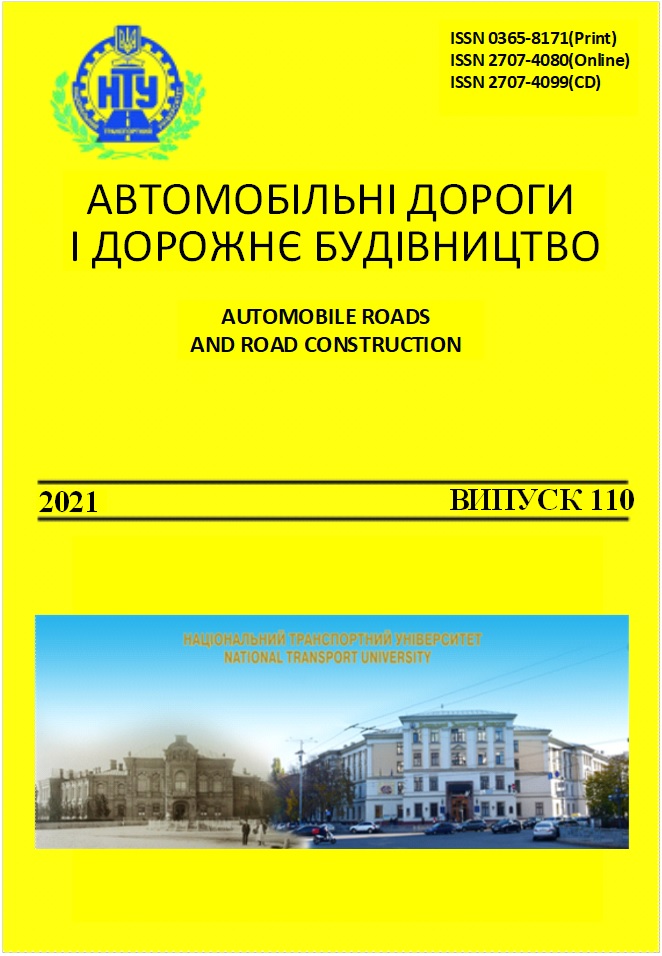Prospects of using penetrated cement concrete in the construction of transport infrastructure objects
Igor Gameliak, National Transport University, https://orcid.org/0000-0001-9246-7561
Innesa Rutkovska, National Transport University, https://orcid.org/0000-0001-7832-4222
Alla Herasimenko, National Transport University, https://orcid.org/0000-0001-7038-3703
Marya Filishchuk, National Transport University, https://orcid.org/0000-0002-0195-1006
Abstract: This article presents the analysis of the international experience of the use of pervious concrete in transport infrastructure. It provides the advantages and disadvantages of the material and the results of personal laboratory tests of relevant concrete samples.
The object of the research is the use of pervious concrete in the construction of transport infrastructure.
The objective of the paper is to justify the use of pervious concrete in the construction of transport infrastructure by analyzing previous international experience and lab tests of the corresponding concrete samples.
Research methods included a analysis of the international and domestic literature, the evaluation of the experience in the use of the pervious concrete, and laboratory tests of the corresponding concrete samples.
A review of the world experience connected with research of pervious (draining) concrete, installation and operation of layers of aerodrome surface made of it, proved their technical and economic relevance and effectiveness of their application. Pervious concrete is a material with high open porosity, which provides good sound-absorbing properties and drainage ability together with roughness, smoothness, and transverse friction.
These are advantages of pervious concrete pavements, according to foreign studies: a rapid removal of water from the surface of the pavements in case of rain and improved drainage of road and airfield pavements reduce the risk of aquaplaning vehicles and increase traffic safety in rainy weather; increased and stable surface roughness; reduced level of noise provided by vehicles. The draining ability of the pavements makes it almost dry. It also has a high degree of sound absorption.
The results of the article can be implemented in various technologies of construction and repair of transport infrastructure.
The search for the optimal composition of pervious concrete for its further use in the technology of construction and repair of various objects is the main purpose of predictive assumptions about the development of the object of study.
Article language: Ukrainian
Referenses:
- Pavlihin N.V., Kuzmin P.V. Modernizatsia transportnih koridoriv v umovah ekonomichnoi nestabilnosti [Modernization of transport corridors in conditions of economic instability]. Irpin, 2011. issue 11, pp. 404-417.
- American Concrete Institute. Pervious Concrete. ACI Committee 522, technical committee document 522R-06, 2006.
- Tennis, P.D., Leming, M.L., and Akers, D.J. Pervious Concrete Pavements. EB302, Portland Cement Association, Skokie, Illinois, and National Ready Mixed Concrete Association, Silver Spring, Maryland, 2004.
- DSTU 8858:2019 Sumishi tsementobetonni dorozhni ta tsementobeton dorozhnii. Tekhnichni umovy.
- Radovskyi B.S. Veroiatnostno-heometrycheskyi podkhod k strukture y otsenke fyzyko-mekhanycheskykh svoistv materyalov dorozhnoi konstruktsyy. Novoe v proektyrovanyy konstruktsii odezhd. M: 1988. S. 37–50.
- Chandrappa A. and Biligiri K. Pervious concrete as a sustainable pavement material – Research findings and future prospects: a state-of-the-art review. Construction and Building Materials, 111: 2016. PP. 262–274.
- Lange Yu. H. Primenenie poristogo (dreniruyushchogo) tsementobetona pri stroitelstve sloyev dorozhnoy odezhdy [The use of porous (drainage) cement concrete in the construction of pavement layers. Survey information]. issue 6. Available at: https://files.stroyinf.ru/Data1/56/56228/index.htm
- Deo O. and Neithalath N. A review of sustainable drainage systems (SuDS): a soft option for hard drainage. Geography. 88 (2): 2011. РР. 99–107.
- Nguyen D.H., Sebaibi N., Boutouil M., Leleyter L. and Baurd F. Wetlands (third edition). Chichester: Wiley. 2014.
- Yahia A. and Kabagire D. Hydrologic behaviour of stormwater infiltration trenches in a central urban area during 2/3 years of operation. Water Science and Technology, 39 (2): 2014. PP. 217–224.
- L. Sivakumar Babu, Prithvi S. Kandhal, Nivedya Mandankara Kottayi, Rajib Basu Mallick, Amirthalingam Veeraragavan. Pavement Drainage. Theory and Practice. New York. CRC Press Taylor & Francis Group. 2019. 243 р.
- Fu, T.F., Yeih, W., Chang, J.J. and Huang, R. 2014. The influence of aggregate size and binder material on the properties of pervious concrete. Journal of Advances in Materials Science and Engineering, 2014: 17 p.
- Zhong R., Wille K. Material design and characterization of high performance pervious concrete. Construction and Building Materials, 2015, issue 98 (9), pp.51-60. DOI: 10.1016/j.conbuildmat.2015.08.027.
- John T. Kevern. Evaluating Permeability and Infiltration Requirements for Pervious Concrete. Journal of Testing and Evaluation. 2007. РР. 544-553.
- Kuang X., Sansalone, J., Ying, G. and Ranieri, V. 2010. Pore-structure models of hydraulic conductivity for permeable pavement. Journal of Hydrology, 399: PP. 148–157.
- Illgen, M. 2008. Infiltration and surface runoff processes on pavements: Physical phenomena and modelling. 11th International Conference on Urban Drainage, Edinburgh, Scotland, UK, 2008.
- Illgen, M., Harting, K., Schmitt, T.G. and Welker, A. 2007. Runoff and infiltration characteristics of pavement structures – review of an extensive monitoring program. Water Science and Technology, 56 (10): PP. 133–140.
- Kováč1 M., Sičáková A. Pervious concrete as a sustainable solution for pavements in urban areas. Kováč, A. Sičáková. “Environmental Engineering” (27–28.04.2017) 10th International Conference. Lithuania, 2017, pp. 2-8.
Open Access: http://publications.ntu.edu.ua/avtodorogi_i_stroitelstvo/110/69.pdf
Online publication date: 25.02.2021
Print date: 01.02.2021
